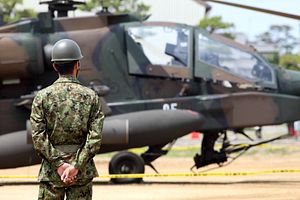The Japanese Defense Ministry is making significant progress in consolidating the practical gains of the government’s new laws allowing for the export of defense equipment and technology, as well as the Cabinet’s new interpretation of collective self-defense. These moves indicate that the ministry and the government are optimistic that these new policies will not incur significant opposition during the special Diet session this fall or the regular session next year. The government of Prime Minister Shinzo Abe in particular is taking the opportunity to implement a comprehensive approach that sees the production of new, Japanese developed arms, creating a regional market for their export in order to sustain the industry, and the training of a new marine force capable of defending remote islands, as envisioned by the new collective self-defense policy.
After reaching a significant defense trade and technology deal with Australia this summer, Japan appears ready to make a much larger foray into regional arms sales after reducing restrictions on its arms exports in the spring. Government sources said on Sunday that Japan plans to hold a seminar in Tokyo this September to pitch the sale of Japanese defense equipment to ASEAN member countries. “Maritime security” is expected to be the main theme, with officials explaining “how Japanese vessels and aircraft could boost the security of ASEAN countries.” The government also said that Japan’s own new defense posture “will improve if ASEAN countries increase their own deterrence capabilities in the face of China’s growing maritime assertiveness.” Japan’s own new rules on arms trade require a defense equipment transfer accord before any defense equipment or technology deal is made, however, given the tense situation between China and some ASEAN members, countries like the Philippines and Vietnam could be expected to quickly sign accords with Japan in order to begin importing military goods, particularly patrol vessels.
Aside from attempting to expand the market for Japan’s current military hardware, the Ministry of Defense has also announced plans to create a fund that will aid universities in joint research projects to develop new defense technology. The fund would start with 2 billion yen ($19.5 million) in fiscal 2015 and increase to 6 billion yen over the next three years. It would be modeled on the U.S. Defense Advanced Research Projects Agency, and look to promote joint projects in aviation and surveillance radar technology. The development of defense technology has until now been the sole domain of the government; however, the Defense Ministry is seeking to capitalize on Japan’s indigenous and world-class research facilities. Japanese academia’s controversial history of contributing to defense efforts in the Second World War will make collaboration difficult, as will the reluctance of many of the country’s researchers. However, with research funds increasingly in short supply, the government “could be seen as offering financial incentives to cash-strapped researchers to get them to focus on defense technologies.”
The government also decided on Tuesday to announce more details on the training of its Ground Self-Defense Forces’ Western Army Infantry Regiment stationed at Camp Ainoura near Nagasaki, which are expected to later form the nucleus of a Japanese special-forces unit modeled on the U.S. Marine Corps and tasked with the potential retaking and defense of remote islands, according to the Asahi Shimbun. The media was allowed to observe the latest round of training at the nearby Kujukushima island chain on July 16, which displayed the troops’ landing capabilities. The unit has conducted six joint training exercises with the U.S. Marines this year, and is currently training other SDF soldiers who will eventually constitute the new marine infantry force.
These latest moves, alongside Japan’s new plans to increase the defensive capabilities of its remote islands, show a concerted and dedicated effort by the government to quickly consolidate the gains it’s made in defense legislation and reinterpreting its pacifist Constitution. In many ways, these are the actions of fully normalized military that is attempting to sustain and increase the capabilities of the domestic arms market, which is necessary to propel it into the future. Additionally, a rational state actor would develop the forces necessary to defend a series of far-flung and hotly contested islands. However, Japan is not quite yet a fully normalized state security participant. Moreover, some of its closest neighbors like China, Taiwan and South Korea will not accept it as such for the foreseeable future. Japan appears to be prepared to accept that tension with its neighbors, while developing ties with allies further abroad. So far Japan has been able to maintain this tense balancing act, with no signs of slowing down on the security front.

































